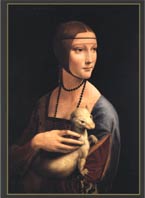Wednesday, November 09, 2011 -  Czartoryski Museum,Krakow,Leonardo da Vinci,Nazi art theft,Poland
Czartoryski Museum,Krakow,Leonardo da Vinci,Nazi art theft,Poland
 No comments
No comments
 Czartoryski Museum,Krakow,Leonardo da Vinci,Nazi art theft,Poland
Czartoryski Museum,Krakow,Leonardo da Vinci,Nazi art theft,Poland
 No comments
No comments
The Collecting History of Stolen Art: Da Vinci's "Lady with an Ermine"
 |
| Da Vinci's "Lady with an Ermine" |
by Catherine Schofield Sezgin, ARCA blog editor-in-chief
Leonardo Da Vinci's "Lady with an Ermine created a sensation with the public in Berlin for the past few months during its first trip out of Poland since the masterpiece was recovered from the Nazis after the end of World War II.
Today it opened at the National Gallery in London as part of the exhibition, "Leonardo da Vinci: Painter at the Court of Milan". Conservationists have insisted that once the painting returns from London in February 2012 that it will remain in Krawków for at least ten years (The News.pl).
Today it opened at the National Gallery in London as part of the exhibition, "Leonardo da Vinci: Painter at the Court of Milan". Conservationists have insisted that once the painting returns from London in February 2012 that it will remain in Krawków for at least ten years (The News.pl).
In 1489, just some 20 years after artists began using oil paints, 37-year-old Da Vinci used oils when his employer, Lodovico "Il Moro" Sforza, the Duke of Milan, commission the Renaissance master to paint his 15-year-old mistress, Cecilia Gallerani, on a 21 by 15-inch walnut wood panel. When "Il Moro" married someone else, Cecilia had to leave the palace but took the portrait with her. "Il Moro gave her a dowry and a castle outside Milan where she spent the rest of her life with her husband Count Pergamino," according to the Czartoryski Museum.
Princess Isabela Czartorska founded the Czartoryski Museum in 1796. Two years later, her son, Prince Adam Jerzy, travelled to Italy and purchased Da Vinci's "The Lady with an Ermine" (and the still missing painting by Raphael "Portrait of a Young Man"). Condemned to death by the Russians after the 1830 November Uprising of the Russian-Polish war, Prince Jerzy fled to Paris, bought The Hotel Lambert, and set up the Living Museum of Poland (displaying all the objects from the first museum).
"Lady with an Ermine", which has only travelled cautiously since its return to Poland after World War II, travelled extensively in escaping to safety throughout various wars.
In 1871, after the French defeat in the Franco-Prussian War, Prince Jerzy's son packed or hid all of the museum's objects and fled. In 1874, the city of Krakow offered him a building and four years later the current museum opened.
To protect the works from war in 1914, the most important objects were taken to Dresden by the Czartorska family which continued to manage the museum. The collection was finally restored to the museum in Krakow in 1920.
In August 1939, on the eve of the invasion of Poland, cases of objects were hidden but later found by the Germans. In January 1940, 85 of the most important objects are sent back to Dresden to be part of Hitler's collection at Linz. The paintings went to Berlin then Neuhaus before being claimed by the Polish representative at the Allies Commission for the Retrieval of Works of Art on behalf of the Czartoryski Museum (excluding the Raphael and 843 other artefacts).
The communist government operated the museum behind the Iron Curtain until 1991 when the museum was returned to its rightful owner, Prince Adam Karol Czartoryski, who set up a foundation to oversee the museum today.
"The Lady with an Ermine" travelled to Milwaukee Art Museum in 2002 and to Houston and San Francisco in 2003. This year the painting travelled from Madrid to Berlin.

